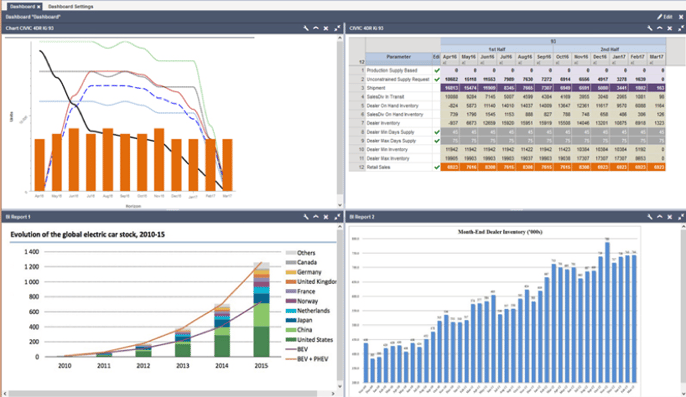Sales & Operations Planning Drives Manufacturing Efficiency
Robin Hornung - April 28, 2020

Sales & Operations Planning (S&OP) is an essential tool that ensures the efficient operations of the enterprise by providing reliable short- to long-range forecasts of market needs. Internal resources can then be allocated to meet a production target without incurring unnecessary additional costs. S&OP solutions allow business decision makers to consider the capacity side as well as the sales side, which results in an ideal market supply and better outbound logistic inventories.
S&OP is a highly effective complement to ERP and MES solutions during normal business cycles. It can become a critical component when planners are confronted by an unexpected variable in the production process. When faced with an unforeseeable disruption, like a natural disaster, tariff dispute, or some other calamity, companies need to react in an intelligent way to avoid a negative impact.
Unanticipated disruptions can derail the smooth operations of manufacturing in a highly competitive, global economy. In a sudden turn of events, it’s often a challenge for manufacturers to find alternative sources for critical parts to prevent an interruption of production.
This is particularly true for the automotive industry, which is dependent on suppliers, manufacturers, and customers in countries throughout the world.
The Unique Requirements of Forecasting for Automobile Manufacturers and Suppliers
Unlike for consumer goods, commodities, and simpler products, it is not possible to apply statistical forecasting as a basis for sales planning in the automotive industry.
The issue lies in reference horizons which tell individual stories: hot products vs. cold products, strong market vs. weak market, strong competition vs. weak competition, etc.
Trending and other methods of statistical forecasting with extrapolation of references from the past into future planning cycles cannot forecast accurately and predict free market demands. Historical sales figures are often driven by capacity restrictions, incentive initiatives, and other demand influencing factors.
AI and the analysis of social media is one possible source to verify capacity needs, but it’s not yet in a state where it can provide reliable results. Perhaps the technology will mature and be able to accurately forecast volume demand in 5-10 years, but not today.
That said, a viable alternative does exist. By analyzing performance KPIs of daily and monthly sales using metrics available with today’s technology solutions, along with information sources like micro- and macro-economic predictions by analysts, the seasonality patterns of sales can be defined with a greater degree of certainty than ever before.
The Product Lifecycle
All of this information must be available to planners who can then make the best educated forecast of needed bandwidth and risk factor parameters. Smart S&OP not only means the ability to accurately forecast demand and establish the referring capacity, but also to forecast the bandwidth needed to provide flexibility.

In the automotive industry, planning typically occurs on different levels of the product hierarchy, never on fully specified products; there are simply too many variables.
Planning exists at higher levels, for example, on model selection or trim or option packages. An S&OP solution has to provide this level of detail for the planners to maintain consistent production.
Manufacturers rely on sophisticated ERP solutions for the efficient operations of the enterprise–but ERP solutions alone are not adequate to help companies pivot to new strategies when confronted with an unforeseen disruption.
Sales & Operations Planning (S&OP) technology solutions complement the power of ERP platforms and provide manufacturers with the opportunity to plan for how to overcome potentially crippling crises.
Strategic and Tactical Planning Processes
An integrated and agile plan not only considers today’s market conditions, but also anticipates future conditions, including strategic and tactical planning processes.

With sales planning, manufacturers can quickly revise expectations for sales and corresponding production output. Short- and long-range forecasts are highly volatile and companies must respond quickly to changing market conditions which have to be responded to with adjustments of production volumes and capacities.
Production and capacity planning anticipates required parts and capacities while taking into consideration working time models and line speeds, including losses through plant and equipment changes and other sources of downtime in the plants and lines. A continuous balancing of demand and capacity minimizes the risk of disruption in supply availability and allows just enough flexibility for late order changepoints.
Using inventory planning, companies can supply markets with the ideal product inventory. In the journey through the supply chain from raw materials to finished goods, when the product reaches the point of sale there can be many required adjustments. Planning makes that possible by considering multiple What-if? scenarios.
What About What-if?
By using What-if exercises, manufacturers can quickly respond to changing situations and accurately determine the best solution after considering all potential options. What-if scenarios allow for intelligent planning through the weighing of alternative options, decision validations, and finding the most profitable solution.
Good Data Drives Good Decision-Making
Business decisions concerning investments on the capacity side and on the sales side are based on the S&OP process and its KPIs. Decision-making is supported by powerful computing technology allowing end-to-end visibility and full transparency into the enterprise at any time.

Graphical dashboards display embedded analytics and enable decision-makers to quickly turn immense amounts of data into actionable decisions. Individual panes can be combined based on the specific information needs of management, providing insight into the most relevant data points.
Planning Makes Perfect
Establishing the sales organization, production network, and product structure as early as possible in the product lifecycle means that the organization can accurately forecast resource needs.
No manufacturing enterprise can operate at optimum efficiency without a robust Sales & Operations Planning solution working with its ERP platform. This technology is even more crucial when market conditions require a quick pivot to maintain production continuity due to globally disruptive events like an earthquake, the coronavirus, or a trade war.
No S&OP solution can predict when a game-changing event will strike, but it can provide the tools to consider alternative courses of action, identify the best options to meet the challenge, and minimize damage.
A robust S&OP solution working with a comprehensive ERP platform gives manufacturers the tools to operate at maximum efficiency while retaining the flexibility to respond quickly when market conditions dictate.
If you want to learn more get your Guide to Sales & Operations Planning
In this Guide you will learn:
-
Why a S&OP Process is important
-
How a S&OP System can be flexible and quickly implemented
-
Central tasks of a S&OP System
-
The key to more productivity
LATEST POSTS
- Understand Why Production Planning Needs Specialized Solutions
- Understand Circular Economy in The Manufacturing Industry
- How Can Industry 4.0 IT Integration Be Achieved Smoothly?
- The Significance of Order Sequencing in Discrete Manufacturing
- How to improve your Supply Chain Management: The Power of Control Towers



